Articles
- Page Path
- HOME > J Korean Acad Nurs > Volume 44(4); 2014 > Article
-
Original Article
- Association between Efficiency and Quality of Health Care in South Korea Long-term Care Hospitals: Using the Data Envelopment Analysis and Matrix Analysis
- Minsung Sohn, Mankyu Choi
-
Journal of Korean Academy of Nursing 2014;44(4):418-427.
DOI: https://doi.org/10.4040/jkan.2014.44.4.418
Published online: August 29, 2014
1Department of Public Health Science, Graduate School·BK21Plus Program in Public Health Science, Korea University, Seoul, Korea.
2School of Health Policy & Management, College of Public Health Science·Department of Public Health Science, Graduate School·BK21 Plus Program in Public Health Science, Korea University, Seoul, Korea.
- Address reprint requests to: Choi, Mankyu. Justice hall 703, Department of Public Health Science, Graduate School, Korea University, San 1, Jeongneung 3-dong, Seongbuk-gu, Seoul 136-703, Korea. Tel: +82-2-940-2871, Fax: +82-2-940-2879, mkchoi@korea.ac.kr
© 2014 Korean Society of Nursing Science
This is an Open Access article distributed under the terms of the Creative Commons Attribution NoDerivs License. (http://creativecommons.org/licenses/by-nd/4.0/) If the original work is properly cited and retained without any modification or reproduction, it can be used and re-distributed in any format and medium.
Abstract
-
Purpose
- Objectives of this study were to investigate the association between efficiency and quality of health care in Long-term Care Hospitals (LTCH) and determine related factors that would enable achievement of both high efficiency and high quality at the same time.
-
Methods
- Major data sources were the "2012 Korean Assessment of Propriety by Long-term Care Hospitals" obtained from the Health Insurance Review & Assessment Service. Cost variables were supplemented by a National Tax Service accounting document. First, data envelopment analysis was performed by generating efficiency scores for each LTCH. Second, matrix analysis was conducted to ascertain association between efficiency and quality. Lastly, kruskal-wallis and mann-whitney tests were conducted to identify related factors.
-
Results
- First, efficiency and quality of care are not in a relationship of trade-offs; thus, LTCH can be confident that high efficiency-high quality can be achieved. Second, LTCH with a large number of beds, longer tenure of medical personnel, and adequate levels of investment were more likely to have improved quality as well as efficiency.
-
Conclusion
- It is essential to enforce legal standards appropriate to the facilities, reduce turnover of nursing staff, and invest properly in human resources. These consequences will help LTCH to maintain the balance of high efficiency-high quality in the long-run.
- 1. Statistics Korea. Population projections for Korea: 2010-2060. Daejeon: Author; 2011.
- 2. Health Insurance Review & Assessment Service. 2011 national health insurance statistical yearbook. Seoul: Health Insurance Review & Assessment Service, National Health Insurance Service; 2012.
- 3. National Health Insurance Service. 2013 evaluation results of longterm care facility. Press Release. 2014;04 28.
- 4. The Organisation for Economic Co-operation and Development. OECD health policies and data 2010 [Internet]. Paris, FR, Author. 2010;cited 2014 January 20. Available from: http://www.oecd.org/els/health-systems/
- 5. Health Insurance Review & Assessment Service. Effective management of long-term care hospital. Seoul: Author; 2010.12;Report No.: HETA2000-0139-2824.
- 6. Shimshak DG, Lenard ML, Klimberg RK. Incorporating quality into data envelopment analysis of nursing home performance: A case study. Omega. 2009;37(3):672–685. http://dx.doi.org/10.1016/j.omega.2008.05.004ArticlePubMedPMC
- 7. DeLellis NO, Ozcan YA. Quality outcomes among efficient and inefficient nursing homes: A national study. Health Care Manage Rev. 2013;38(2):156–165. http://dx.doi.org/10.1097/HMR.0b013e31824bec38PubMed
- 8. Nayar P, Ozcan YA, Yu F, Nguyen AT. Benchmarking urban acute care hospitals: Efficiency and quality perspectives. Health Care Manage Rev. 2013;38(2):137–145. http://dx.doi.org/10.1097/HMR.0b013e3182527a4cPubMed
- 9. Lee HY, Blegen MA, Harrington C. The effects of RN staffing hours on nursing home quality: A two-stage model. Int J Nurs Stud. 2014;51(3):409–417. http://dx.doi.org/10.1016/j.ijnurstu.2013.10.007ArticlePubMed
- 10. Berta W, Laporte A, Kachan N. Unpacking the relationship between operational efficiency and quality of care in Ontario long-term care homes. Can J Aging. 2010;29(4):543–556. http://dx.doi.org/10.1017/s0714980810000553ArticlePubMed
- 11. Keaysa S, Wistera AV, Gutmana GM. Administrators and quality of care in long-term care facilities. J Hous Elderly. 2009;23(3):243–260. http://dx.doi.org/10.1080/02763890903035621Article
- 12. Rantz MJ, Hicks L, Grando V, Petroski GF, Madsen RW, Mehr DR, et al. Nursing home quality, cost, staffing, and staff mix. Gerontologist. 2004;44(1):24–38.ArticlePubMed
- 13. Blank JL, Eggink E. A quality-adjusted cost function in a regulated industry: The case of Dutch nursing homes. Health Care Manag Sci. 2001;4(3):201–211.ArticlePubMedPDF
- 14. Anderson RI, Hobbs BK, Weeks HS, Webb JR. Quality of care and nursing home cost-efficiency research. J Real Estate Lit. 2005;13(3):323–336.Article
- 15. Lee I, Wang HH. Preliminary development of humanistic care indicators for residents in nursing homes: A delphi technique. Asian Nurs Res. 2014;8(1):75–81. http://dx.doi.org/10.1016/j.anr.2014.03.001Article
- 16. Garavaglia G, Lettieri E, Agasisti T, Lopez S. Efficiency and quality of care in nursing homes: An Italian case study. Health Care Manag Sci. 2011;14(1):22–35. http://dx.doi.org/10.1007/s10729-010-9139-2ArticlePubMedPDF
- 17. Lee RH, Bott MJ, Gajewski B, Taunton RL. Modeling efficiency at the process level: An examination of the care planning process in nursing homes. Health Serv Res. 2009;44(1):15–32. http://dx.doi.org/10.1111/j.1475-6773.2008.00895.xArticlePubMedPMC
- 18. Duffy JAM, Fitzsimmons JA, Jain N. Identifying and studying "best-performing" services: An application of DEA to long-term care. Benchmarking. 2006;13(3):232–251. http://dx.doi.org/10.1108/14635770610668767
- 19. Lee SH. Multi-level analysis of factors related to quality of service in long-term care hospitals. J Korean Acad Nurs. 2009;39(3):409–421. http://dx.doi.org/10.4040/jkan.2009.39.3.409ArticlePubMed
- 20. Cooper WW, Seiford LM, Zhu J. Data envelopment analysis: History, models and interpretations. In: Cooper WW, Seiford LM, Zhu J, editors. Handbook on data envelopment analysis. 2nd ed. New York, NY: Springer; 2011. p. 1–39.
- 21. Nayar P, Ozcan YA. Data envelopment analysis comparison of hospital efficiency and quality. J Med Syst. 2008;32(3):193–199.ArticlePubMedPDF
- 22. Donabedian A. Quality assessment and assurance: Unity of purpose, diversity of means. Inquiry. 1988;25(1):173–192.PubMed
- 23. Charnes A, Cooper WW, Rhodes E. Measuring the efficiency of decision making units. Eur J Oper Res. 1978;2(6):429–444. http://dx.doi.org/10.1016/0377-2217(78)90138-8Article
- 24. O'Neill L, Rauner M, Heidenberger K, Kraus M. A cross-national comparison and taxonomy of DEA-based hospital efficiency studies. Socioecon Plann Sci. 2008;42(3):158–189. http://dx.doi.org/10.1016/j.seps.2007.03.001Article
- 25. Zhu J. Super-efficiency and DEA sensitivity analysis. Eur J Oper Res. 2001;129(2):443–455. http://dx.doi.org/10.1016/S0377-2217(99)00433-6Article
- 26. Martilla JA, James JC. Importance-performance analysis: An easily-applied technique for measuring attribute importance and performance can further the development of effective marketing programs. J Mark. 1977;41(1):77–79.
- 27. Zhang NJ, Unruh L, Wan TT. Has the medicare prospective payment system led to increased nursing home efficiency? Health Serv Res. 2008;43(3):1043–1061. http://dx.doi.org/10.1111/j.1475-6773.2007.00798.xArticlePubMedPMC
- 28. Bostick JE, Rantz MJ, Flesner MK, Riggs CJ. Systematic review of studies of staffing and quality in nursing homes. J Am Med Dir Assoc. 2006;7(6):366–376. http://dx.doi.org/10.1016/j.jamda.2006.01.024ArticlePubMed
- 29. Castle NG, Engberg J. Staff turnover and quality of care in nursing homes. Med Care. 2005;43(6):616–626.ArticlePubMed
- 30. Newhouse JP. Toward a theory of nonprofit institutions: An economic model of a hospital. Am Econ Rev. 1970;60(1):64–74.
REFERENCES
Figure & Data
REFERENCES
Citations

- Optimising efficiency and patient-centredness in general hospitals: insights from data envelopment and matrix analysis
Hyunseo Lee, Minsung Sohn, Mankyu Choi
Journal of Health Organization and Management.2025; 39(6): 974. CrossRef - The influence of professional competency, professional commitment, and nursing organizational culture on the person-centered practice of nurses in long-term care hospitals: A cross-sectional study
Yoon Saeng Choi, Su Hyun Kim
Journal of Korean Gerontological Nursing.2023; 25(2): 116. CrossRef - Uzun Dönemli Bakım Etkinliğinin Değerlendirilmesi: OECD Ülkeleri Üzerinde Bir Araştırma
Yasin ÇİLHOROZ, İlknur ARSLAN ÇİLHOROZ
Karadeniz Sosyal Bilimler Dergisi.2022; 14(26): 70. CrossRef - Regional Differences and Influencing Factors of Allocation Efficiency of Rural Public Health Resources in China
Tao Liu, Jixia Li, Juan Chen, Shaolei Yang
Healthcare.2020; 8(3): 270. CrossRef - Has the long-term care insurance resolved disparities in mortality for older Koreans? examination of service type and income level
Minsung Sohn, Patricia O'Campo, Carles Muntaner, Haejoo Chung, Mankyu Choi
Social Science & Medicine.2020; 247: 112812. CrossRef - Efficiency Analysis of East Asian Zinc Smelters and the Effects of Capacity and Bonus Zinc on Efficiency
Ha Sung Park, Daecheol Kim
Journal of Open Innovation: Technology, Market, and Complexity.2019; 5(1): 4. CrossRef - Difference in Recognition of Internal Customer Service Quality of Outsourcing Staff in Hospital Using IPA
Sung-Soo Kim
Journal of Health Informatics and Statistics.2018; 43(1): 80. CrossRef - Relationship between Medical Service Specialization and Operational Performance in Hospitals: Focusing on Length of Stay and Medical Expense
Hai-Won Yoo, Kyoung-Hoon Kim
The Korean Journal of Health Service Management.2016; 10(1): 1. CrossRef - Person-centered Care and Nursing Service Quality of Nurses in Long-term Care Hospitals
Hae Sagong, Ga Eon Lee
Journal of Korean Academy of Community Health Nursing.2016; 27(4): 309. CrossRef - A Study on Fitness Evaluation for Major Education of Competency Unit Element by the Development and Application of Subject Contents Based on NCS of Health Majoring Students at Junior Colleges
Min-Ja Kim, Hee-Jung Yang
Journal of the Korea Academia-Industrial cooperation Society.2016; 17(8): 508. CrossRef

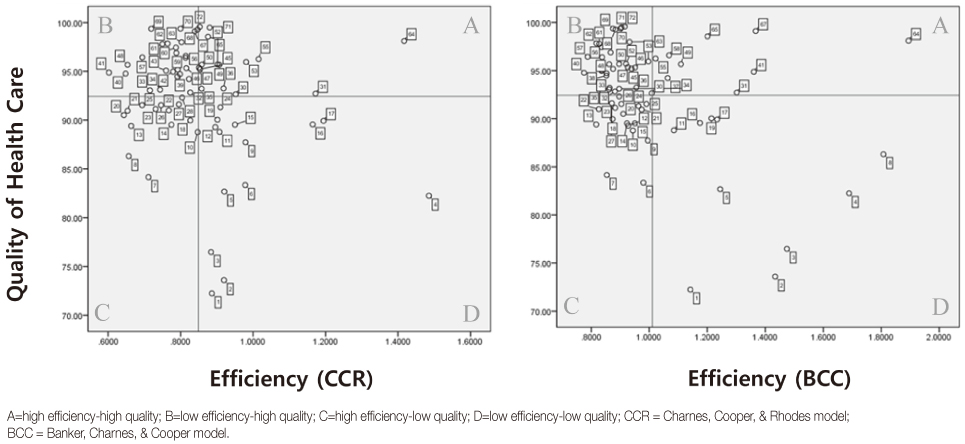
Figure 1
Figure 2
Characteristics of the Long-term Care Hospitals (N=72)
LTCH=Long-term care hospitals.
Characteristics of the Long-term Care Hospitals (N=72)
big=beyond the possible efficiency score from the super-efficiency model; DMU=Decision making unit; CCR=Charnes, cooper, & rhodes model; BCC=Banker, charnes, & cooper model.
Characteristics of the Long-term Care Hospitals (N=72)
A=high efficiency-high quality; B=low efficiency-high quality; C=high efficiency-low quality; D=low efficiency-low quality; CCR = Charnes, Cooper, & Rhodes model; BCC = Banker, Charnes, & Cooper model.
LTCH=Long-term care hospitals.
big=beyond the possible efficiency score from the super-efficiency model; DMU=Decision making unit; CCR=Charnes, cooper, & rhodes model; BCC=Banker, charnes, & cooper model.
A=high efficiency-high quality; B=low efficiency-high quality; C=high efficiency-low quality; D=low efficiency-low quality; CCR = Charnes, Cooper, & Rhodes model; BCC = Banker, Charnes, & Cooper model.
 KSNS
KSNS
 E-SUBMISSION
E-SUBMISSION
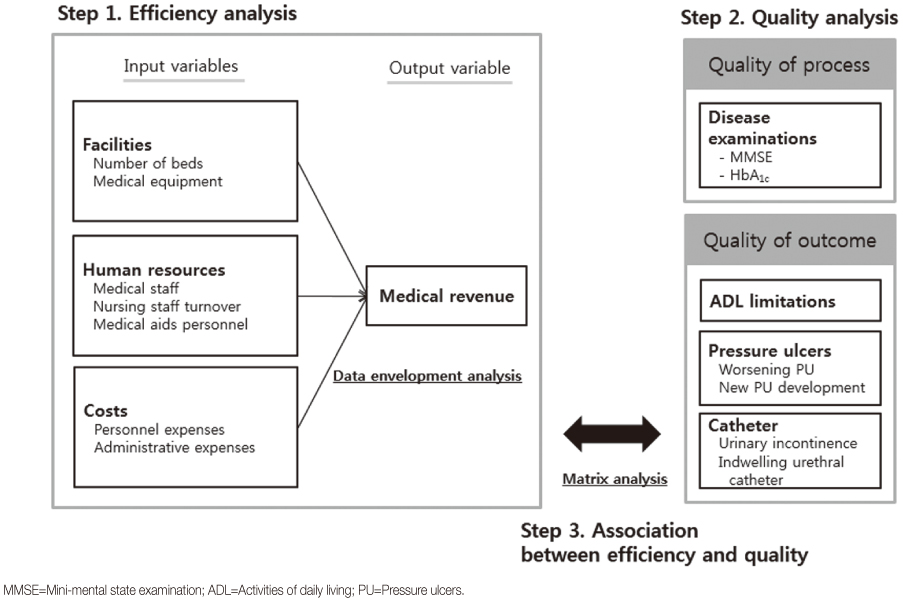

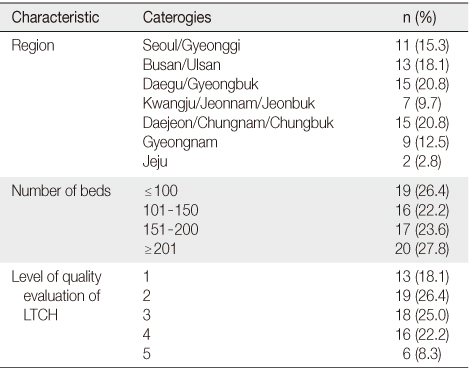
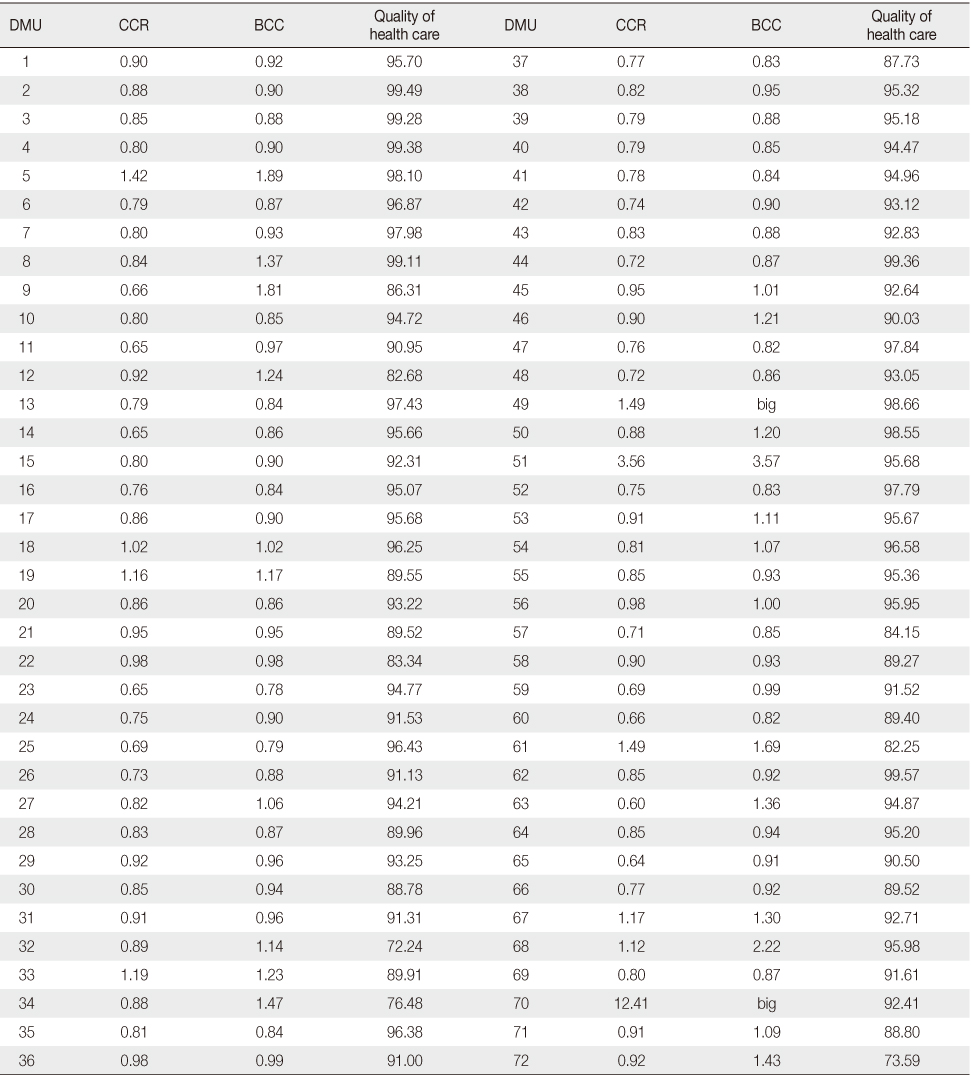
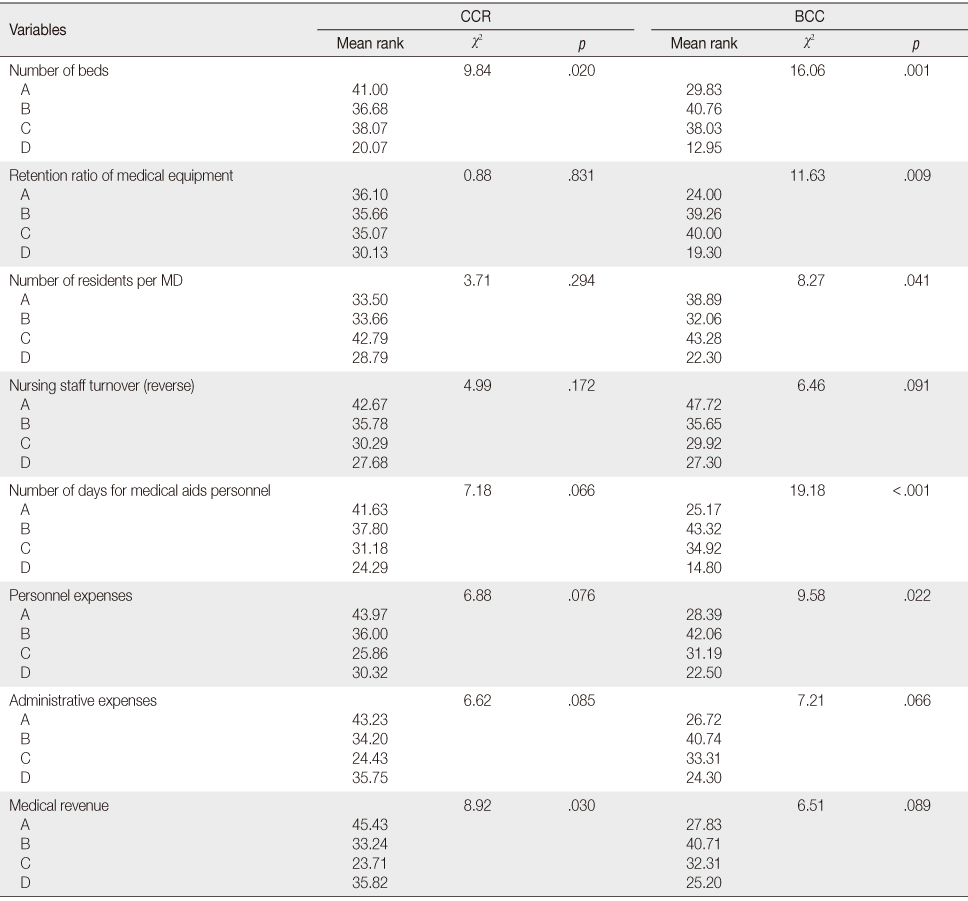
 Cite
Cite

